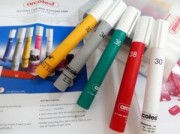
美國ACCU TEST測試液能準確的測試出塑料薄膜之表面張力是否達到測試液的數(shù)值。令使用者清楚的了解此薄膜是否適合于印刷,復(fù)合或真空鍍鋁。有效的控制質(zhì)量及減少因材質(zhì)不合格所造成的損失。它并不僅限于塑料薄膜,還可以測試各種材料的表面張力。 原裝進口測試液有30-72數(shù)十個品種。一般來說,基材形成墨滴,涂層和粘貼能力和表面的能量相關(guān)。如果基材表面的能量低于所涂測試液的表面的張力,則形成珠點和畫線收縮。因而,對大多數(shù)的基于印刷,塑料的溶劑來說,測試筆的要求在36-40達因/厘米之間。基于墨的些液體要求測試筆在40-44達因/厘米之間。而一些碾壓和涂層的應(yīng)用要求表面能量在50達因/厘米或者以上。顯而易見,在進行印刷,涂層和碾壓前需要對表面的能量先預(yù)估。ACCU TEST測試液在絕大多數(shù)的非粘貼性的材料上表現(xiàn)良好。重要的是測試液不會改變基材的表面特性。例如,如果測試液滲入一個纖維基材(如紙)致使膨脹,結(jié)果可以說明其容易潮濕。基材和測試液間的生化反應(yīng)使結(jié)果無效。為了確保測試結(jié)果的可重復(fù)性,材料的準備和測試的方法必須標準化。ASTM STD D6182協(xié)議規(guī)定了測試條件以及方法。 For Medical & Emergency Only MATERIAL SAFETY DATA SHEET 1.PRODUCT INFORMATION PRODUCT NAME: ACCU TEST CHECK PENS 30-60 NFPA Hazard Signal Health – 1; Stability – 0; Flammability – 0; Special – C 2.PHYSICAL DATA BOLING POING: 135 C to 210 C Freezing Point -90 C to +2 C (at 760 mm Hg) (at 760 mm Hg) SPECIFIC GRAVITY: 0.93 to 1.13 Vapor Pressure, 0.08 – 3.75 at 20 C (H20 = 1.0) mm Hg, at 20 C VAPOR DENSITY: 3.1 Solubility in water, Complete At 20 C (air = 1) % by wt. At 20 C Percent Volatiles 100% Evaporation Rate 0.32 to 0.60 (by volume) (Butyl Acetate = 1) APPEARANCE & ODOR: Blue solution with mild, non-residual odor 3.HAZARD SPECIFICATIONS
These hazards are associated with the fluids contained in ACCU TEST CHECK PENS Reproductive Toxin Skin Hazard TLV=20 to 200ppm Eye Hazard Kidney Toxin PEL=5ppm (8 hr weighted avg.) Sensitizer Toxic Agent EPA Hazardous Waste Class: n/a Combustible Liquid Skin Irritant DOT Hazard Class: n/a 4.FIRE & EXPLOSION HAZARD DATA Flash Point: 108 F to 245 F, per ASTM D56; tag closed cup. Autoignition Temperature: n/a Flammability limits in air (by vol. At 200 F): 1.7% to 15.6% Extinguishing Media: Water fog recommended: CO2 dry chemical, and universal foam media, as applied by manufacturer’s recommendations, can also be used. Unusual Fire/Explosion Hazards: Can react with oxidizing materials. ACCU TEST CHECK PENS Page 2 5.HEALTH HAZARD DATA: Inhalation: Vapors are irritating to eyes, nose, and respiratory tract. May cause headache, nausea, vomiting, weakness. Skin Contact: May cause irritation. Wear protective gloves. Ingestion: See inhalation: can also cause breathing difficulty. Kidney damage may result from ingestion of large quantities of test solution. Skin absorption: Prolonged or widespread contact with skin may lead to absorption of harmful amounts of materials resulting in symptoms as described under ingestion. Eye Contact: Cause marked irritation SPECIAL WARING: pregnant women should not use this product; laboratory studies of animal subjects have shown birth defects, delayed fetal development, and increased fetal mortality at air concentrations of 150 to 200ppm. 6.EMERGENCY AND FIRST AID PROCEDURES: Eyes: Flush liberally with running water. Call a physician. Skin: Immediately remove contaminated clothing. Thoroughly wash affected area with soap and water. Inhalation: Remove to fresh air. If breathing if difficult, give oxygen and call a physician. Ingestion: Give large quantities of water. Induce vomiting. Call a physician. 7.REACTIVITY DATA: Decomposes partially at temperatures above 180 Celsius. Do not combine with concentrated alkali at elevated temperatures. Hazardous combustion or decomposition products: CO, NHx.
8.SPILL OR LEAK PROCEDURES: Absorb spill with paper toweling or vermiculite. Once absorbed, evaporate outdoors or incinerate in a chemical burner equipped with an after-burner and scrubber. Dispose of waste product by high temperature incineration, as approved under appropriate federal, state and local legislation. Do not discharge without prior written approval from the appropriate health and environmental authorities. ACCU TEST CHECK PENS Page 3 9.SPECIAL PRECAUTIONS: NOT FOR USE AS A CONSUMER PRODUCT. FOR INDUSTRIAL USE ONLY. Keep this product away from heat and flame. Always use with adequate ventilation. Do not allow fluid to contact skin; wear gloves. WARNING TO PREGNANT WOMEN: Do not use ACCU TEST CHECK PENS unless exposure is extremely low. Even small amounts, if repeatedly inhaled, ingested, or absorbed through skin, may cause fetal malformations. 10.HANDLING AND DISPOSAL GUIDE: ACCU TEST CHECK PENS Flexart Inks, Paints & Coatings, Inc. strongly recommends you wear protective gloves while using these test marker pens; skin contact presents the highest potential for exposure under normal testing conditions. Eye protection and a laboratory coat or apron are also good precautions. Ventilation must be adequate to ensure that vapors will not accumulate; and exhaust hood is ideal, though not absolutely necessary as long as there is reasonable airflow in the test area. Spent material samples must be handled with care: Disposal of these contaminated materials also presents exposure hazards. We suggest you allocate one trash container exclusively for dyne test waste; use an inner liner, keep it covered, and label the lid. “DO NOT HANDLE THIS WASTE WITHOUT PROTECTIVE GLOVES. AVOID SKIN CONTACT.” Outdated pens should be dispositioned by your in-house industrial waste expert via your contracted waste handling firm. The EPA classifies the constituents of these pens as generic solvents, but your local regulations may be more stringent. ALWAYS REVIEW THE MSDS WITH YOUR WASTE- HANDLING FIRM TO ENSURE PROPER HADLING. While Flexart Inks, Paints & Coatings, Inc. believes the information contained herein is factual and the opinions expressed are those of qualified experts, this information is not to be taken as a warranty for which While Flexart Inks, Paints & Coatings, Inc. assumes legal responsibility. It is provided solely for consideration, investigation, and verification. FLEXART ACCU TEST CHECK PENS TESTING METHODS